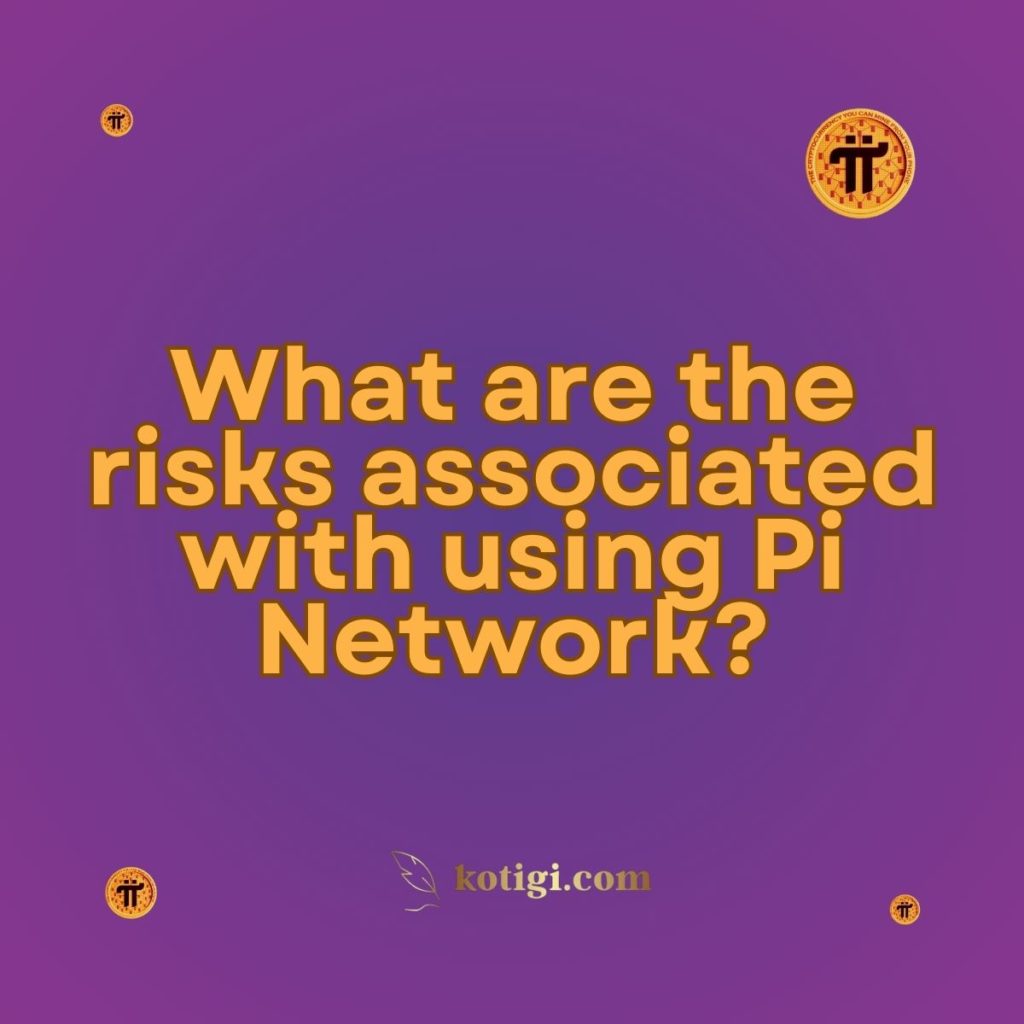
What are the risks associated with using Pi Network?
While Pi Network offers an innovative mobile mining approach to cryptocurrency, users should be aware of the inherent risks involved. These include security vulnerabilities, regulatory uncertainty, centralization issues, and the potential lack of market value. Understanding these risks is essential for anyone considering participation in Pi Network.
Introduction
Pi Network has garnered attention for its unique approach to cryptocurrency mining, allowing users to mine Pi tokens directly from their smartphones without high energy consumption. This model has attracted millions of users eager to join the cryptocurrency revolution. However, like any emerging technology, Pi Network is not without its risks. In this article, we will explore the various risks associated with using Pi Network, including security vulnerabilities, regulatory challenges, market uncertainty, and more. By understanding these risks, users can make informed decisions about their participation in the network.
Comparison table of various risks associated with Pi Network compared to other cryptocurrencies and mobile mining platforms
Here’s a comparison table that outlines various risks associated with Pi Network compared to other cryptocurrencies and mobile mining platforms. This table will help readers quickly grasp how Pi Network’s risks stack up against competitors.
| Aspect | Pi Network | Bitcoin | Ethereum | Electroneum |
|---|---|---|---|---|
| Mining Method | Mobile mining (user-friendly, energy-efficient) | Proof of Work (energy-intensive) | Proof of Stake (energy-efficient, complex) | Mobile mining (similar to Pi, user-friendly) |
| Security Risks | Vulnerable to mobile malware; centralized control | High security through decentralized mining | High security with smart contract capabilities | Potential for mobile malware; less robust security |
| Regulatory Risks | Uncertain global regulations, KYC requirements | Well-established regulatory frameworks | Evolving regulations, especially concerning DeFi | Subject to local regulations and KYC concerns |
| Market Value | No established market value yet | Well-established market value | Well-established market value with significant trading | Limited market value; lower trading volumes |
| Liquidity Risks | Unknown liquidity at launch | High liquidity on exchanges | High liquidity, diverse trading pairs | Moderate liquidity, primarily on niche exchanges |
| Scalability | Potential scalability challenges as user base grows | Scalable through layer 2 solutions like Lightning | Scalable through Ethereum 2.0 upgrades | Scalable, but may face challenges with user growth |
| Community Trust | Depends on the core team’s transparency | Strong community trust built over years | Strong community trust, though facing some skepticism | Moderate trust; newer project |
| Competition | Competes with other mobile mining apps and cryptos | Competes with other major cryptocurrencies | Competes with smart contract platforms | Competes with other mobile mining platforms |
| Privacy Concerns | KYC requirements raise data privacy issues | Anonymous transactions, but blockchain is public | Greater privacy features with zk-SNARKs | KYC requirements raise data privacy issues |
| User Adoption | Requires significant user growth to maintain value | Established user base | Large user base and developer community | Growing user base, but less established than Bitcoin |
This table compares Pi Network with other prominent cryptocurrencies and mobile mining platforms, highlighting key aspects such as mining methods, security risks, regulatory concerns, market value, liquidity, scalability, community trust, competition, privacy issues, and user adoption.
1. Security Risks
1.1 Vulnerabilities in Mobile Mining
The mobile mining model employed by Pi Network presents distinct security vulnerabilities compared to traditional mining setups. Smartphones are inherently less secure than dedicated mining rigs, making them susceptible to malware and hacking attempts. For instance, users may unknowingly download malicious apps masquerading as Pi Network applications, which can lead to the theft of personal information or even mined tokens. Additionally, the reliance on internet connectivity exposes users to potential cyberattacks, compromising their data integrity.
1.2 Lack of Full Decentralization
As it currently stands, Pi Network operates under a semi-centralized model. The centralized control by the core team creates a potential single point of failure. If this centralized entity faces a cyberattack or operational failure, it could jeopardize the entire network and its users. While decentralization is a key tenet of blockchain technology, the current governance structure of Pi Network raises concerns about its long-term security and resilience.
1.3 Phishing and Scams
The popularity of Pi Network has unfortunately attracted scammers who seek to exploit unsuspecting users. Phishing attempts may involve fraudulent communications that appear to be from Pi Network, prompting users to provide sensitive information. These scams can have dire consequences, leading to the loss of both personal data and mined tokens. Users must remain vigilant and verify the authenticity of any communications or applications related to Pi Network.
2. Regulatory and Legal Risks
2.1 Uncertain Regulatory Framework
The cryptocurrency landscape is continuously evolving, and Pi Network exists in a complex regulatory environment. Different jurisdictions have varying laws governing cryptocurrency operations, leading to potential legal ramifications for users. In regions with stringent cryptocurrency regulations, participation in Pi Network could expose users to legal consequences if deemed non-compliant. This uncertainty creates a challenging landscape for Pi Network, as it strives to navigate regulatory expectations while providing a platform for users.
2.2 KYC and Data Privacy Issues
The requirement for users to undergo a Know Your Customer (KYC) process introduces additional risks concerning data privacy. While KYC is designed to enhance security and prevent fraud, it raises questions about how personal data is stored and managed. Users must trust that Pi Network will handle their sensitive information responsibly and comply with relevant data protection laws. Any data breaches or misuse of personal information could have severe implications for users’ privacy and security.
2.3 International Compliance Challenges
Given Pi Network’s global user base, ensuring compliance with a myriad of international regulations presents a formidable challenge. Each country has its own rules regarding cryptocurrency, and non-compliance could lead to significant penalties. This complex regulatory environment could hinder Pi Network’s growth and adoption, potentially leading to operational disruptions if certain jurisdictions impose restrictions.
3. Market Risks
3.1 No Established Market Value
A primary concern for Pi Network users is the absence of an established market value for Pi tokens. Since Pi is not yet traded on exchanges, users have no way of knowing what their mined tokens will be worth once the network fully launches. This uncertainty can lead to frustration among users who invest time and energy into mining without any guarantees of future returns.
3.2 Volatility Upon Listing
When Pi Network eventually lists on cryptocurrency exchanges, the tokens are likely to experience significant price volatility. New cryptocurrencies often undergo rapid price changes as the market determines their value. This volatility can lead to substantial financial losses for users who may not be prepared for the fluctuations that typically accompany new market entrants.
3.3 Liquidity Concerns
Even if Pi gains market value, liquidity could pose a significant challenge. Users might find it difficult to sell their tokens or convert them into fiat currencies due to low trading volumes or lack of demand. A market characterized by low liquidity can exacerbate price volatility, leading to additional risks for users seeking to exit their positions.
4. Centralization and Governance Risks
4.1 Control by Core Development Team
Pi Network’s development and decision-making processes are currently concentrated within its core team. While this centralized control may facilitate rapid development, it also introduces governance risks. Users must place their trust in the team’s ability to make decisions that benefit the broader community. If the team fails to deliver on their promises or makes unpopular decisions, it could erode user trust and participation.
4.2 Unclear Governance Structure
The governance model for Pi Network is still in its infancy, raising questions about how future decisions will be made. A lack of a transparent governance structure can lead to confusion and discontent among users. If users feel disconnected from the decision-making process, it could impact their engagement and commitment to the network.
4.3 Potential for Abuse of Power
With centralized governance, there is also a risk of potential abuse of power. If the core team or any individual within it acts against the interests of the community, it could undermine the fundamental principles of trust and transparency that underpin the network. Users should remain vigilant and advocate for a governance structure that promotes accountability and inclusivity.
5. Scam Risks
5.1 Exposure to Fake Pi Apps and Phishing Scams
Due to its popularity, Pi Network is at risk of being targeted by scammers who create fake applications or websites that impersonate the legitimate platform. These fraudulent entities can deceive users into providing their personal information or logging into fake accounts. Users should be cautious and only download the official Pi Network app from verified sources to mitigate this risk.
5.2 Misleading Advertisements
Additionally, misleading advertisements promoting unrealistic benefits or returns can lure users into scams. These scams often require upfront payments or personal information, resulting in financial loss. Users should exercise skepticism when encountering advertisements that seem too good to be true, ensuring they conduct thorough research before taking any action.
6. Economic Risks
6.1 Inflation Due to Excessive Token Supply
Pi Network’s mining mechanism allows for the rapid generation of new tokens, raising concerns about inflation. If too many tokens are mined before the network’s full launch, the resulting excess supply could dilute the value of individual tokens. This inflationary pressure can diminish the potential rewards for early adopters and impact the overall perception of the network’s value.
6.2 Unproven Economic Model
The economic model behind Pi Network relies heavily on user engagement and community-driven growth. However, this model is largely untested, meaning there is no guarantee that Pi tokens will achieve the anticipated value or utility in the market. Users should be cautious and consider the long-term viability of the economic model before fully committing their time and resources.
6.3 Market Dependency on User Adoption
The success of Pi Network hinges on its ability to attract and retain a robust user base. If interest wanes or users fail to see tangible benefits from mining, the network may struggle to sustain its growth. A decline in user engagement can lead to diminished market confidence, further affecting the network’s potential value and utility.
7. Technical Risks
7.1 Incomplete Network Development
Pi Network is still undergoing development, with many features not fully operational. Users are essentially participating in a beta version of the network, which carries the risk of bugs, crashes, or technical failures. If critical functionalities fail or perform poorly, it could result in a loss of trust among users.
7.2 Scalability Challenges
As the user base grows, Pi Network may encounter scalability issues. If the infrastructure cannot accommodate a large influx of users, it could lead to slow transaction times and inefficiencies. Such scalability challenges could hinder user experience and deter potential new users from joining the network.
7.3 Reliance on Third-Party Technologies
Pi Network’s functionality may depend on various third-party technologies or services, which could introduce additional risks. Any issues or disruptions with these external components could impact the overall performance of the Pi Network, highlighting the need for robust contingency plans.
8. Privacy Concerns
8.1 Centralized KYC Data Storage
The KYC process requires users to submit personal identification data, which is stored in a centralized database. This presents risks related to data privacy; if the centralized storage is compromised, it could expose sensitive user information. Users must weigh the benefits of KYC against the potential privacy risks associated with centralized data handling.
8.2 Limited Transparency on Data Handling
Although Pi Network has privacy measures in place, there is limited transparency about how user data is managed. Users may be unsure of how their data will be used, stored, or shared, which can lead to mistrust. Increased transparency regarding data handling practices can help build user confidence and promote a safer environment.
9. User Trust and Adoption Risks
9.1 Skepticism from the Crypto Community
Despite its user-friendly model, Pi Network faces skepticism from the broader cryptocurrency community. Critics often question the viability of its mobile mining approach and the effectiveness of its growth strategy. This skepticism can hinder broader adoption, limiting the network’s potential user base and market value.
9.2 Trust in the Core Team
The level of trust users have in the core development team significantly influences Pi Network’s credibility. Users need to feel confident that the team is committed to transparency and accountability. If the team fails to demonstrate their reliability, it could erode trust, leading to decreased participation and engagement.
9.3 Challenges in Building Community Engagement
Building a robust community is essential for Pi Network’s success, but fostering active participation can be challenging. If users feel disconnected from the network or do not see tangible benefits, they may be less inclined to engage. Creating meaningful incentives for users to participate actively is crucial for sustaining growth and user loyalty.
10. Competition from Other Projects
10.1 Existing Mobile Mining Platforms
Pi Network is not alone in its quest to offer mobile mining solutions. Other platforms, such as Electroneum, have already established themselves in this niche. Pi Network must differentiate itself by providing unique value propositions to attract users away from competitors.
10.2 Stronger, Established Competitors
In addition to competing with other mobile mining platforms, Pi Network faces fierce competition from well-established cryptocurrencies like Bitcoin and Ethereum. These projects have proven their value and have larger ecosystems, which could draw users away from Pi Network. To remain competitive, Pi must continuously innovate and demonstrate its unique advantages.
Conclusion
Pi Network presents an intriguing opportunity for individuals to engage with cryptocurrency through mobile mining. However, potential users should approach the platform with a clear understanding of the risks involved, including security vulnerabilities, regulatory uncertainties, and market unpredictability. While the project’s innovative approach may offer significant benefits, users must remain vigilant and informed to navigate the complex landscape effectively. Awareness of these risks can empower users to make informed decisions about their participation in Pi Network and the cryptocurrency space as a whole.
Key Takeaways
| Key Takeaway | Details |
|---|---|
| Security Risks | Mobile mining introduces vulnerabilities, and a lack of decentralization raises security concerns. |
| Regulatory Uncertainty | Pi Network’s unclear regulatory status poses legal risks, especially in regions with strict laws. |
| No Guaranteed Value | Pi tokens have no current market value, posing risks for users mining without clear financial returns. |
| Centralization Risks | Pi Network’s centralized control raises concerns about the platform’s governance and future direction. |
| Potential for Scams | The open nature of Pi Network makes it vulnerable to scams and misuse through fake apps and websites. |
| Technical and Scalability Challenges | Incomplete development and potential scalability issues could affect network performance and sustainability. |
| Privacy Concerns | KYC data privacy issues and centralized data handling raise concerns for user information security. |
| Competition from Established Projects | Pi Network faces strong competition from both mobile mining platforms and traditional cryptocurrencies. |





